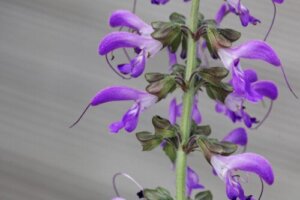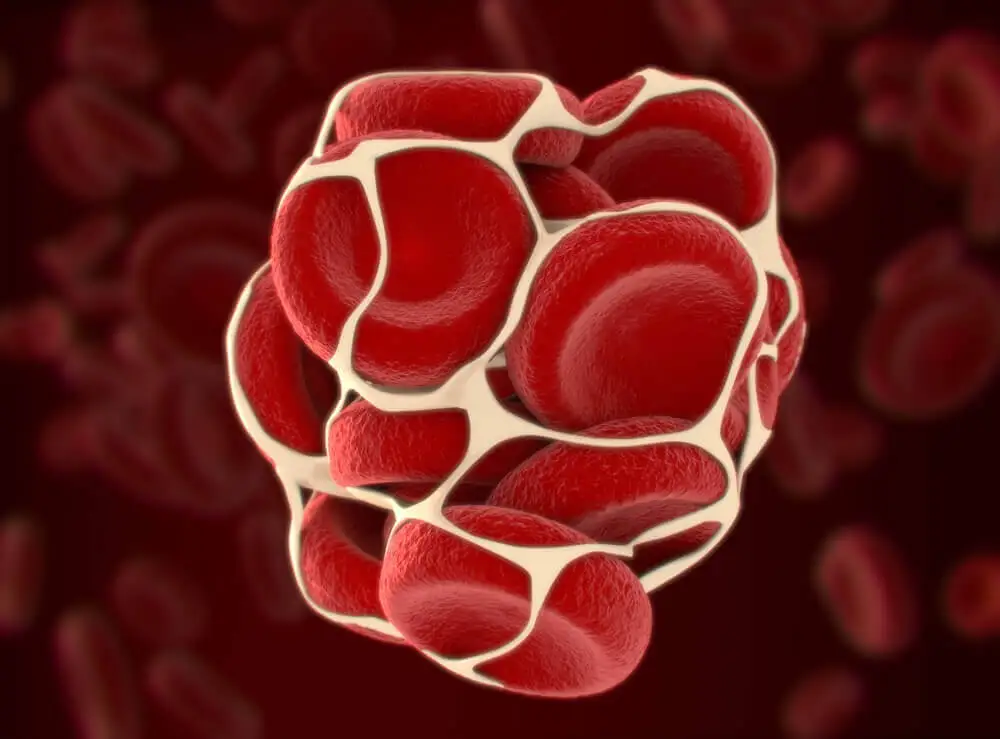Red Sage: Characteristics, Uses and Benefits


Reviewed and approved by the pharmacist Franciele Rohor de Souza
Red sage is also known in traditional Chinese medicine under the name of danshen or tan shen. It’s an ornamental plant that is used as an adjunct to prevent and treat various health problems. Its scientific name is Salvia miltiorrhiza and it shouldn’t be confused with common sage (Salvia officinalis).
According to a review reported in the Chinese Journal of Natural Medicines, this variety of sage contains about 201 polyphenols with pharmacological potential. In particular, it stands out for its antioxidant, anti-inflammatory, antitumor, and antidiabetic properties. Are you interested in knowing more about its applications?
Characteristics of red sage
Red sage is a perennial plant of the genus Salvia, native to China and Japan. It’s characterized by branched stems that measure between 30 and 60 centimeters (12 to 24 inches) in height. Its leaves are spaced and divided, and its flowers grow in spirals in shades ranging from light violet to lavender.
In general, its optimal growing conditions are in places with a sunny, temperate, and humid environment. It’s estimated to need an average temperature of 17.1 °C (63 F) and an average annual humidity of up to 77%.
It’s currently distributed worldwide as an herbal supplement. Some research supports its properties, but it should be used with caution. Like other plants, it has drug interactions and causes side effects.
Uses and benefits of red sage
The pharmacological properties of red sage have been used in Oriental medicine. However, as detailed in a publication in The Journal of Clinical Pharmacology, its uses have spread to the United States and European countries. What benefits are attributed to it? Let’s take a look.
Cardiovascular health
Due to its high content of antioxidant and anti-inflammatory compounds, red sage has been used as a natural remedy to promote cardiovascular health. According to research in Frontiers in Pharmacology, two substances called tanshinone IIA and salvianolate are primarily responsible for these benefits.
In particular, both compounds decrease excess inflammation and free radical accumulation. They also have anticoagulant and vasodilator effects that are important in blood pressure and coagulation.
In addition, another animal study published in the Journal of Cellular and Molecular Medicine found that extracts of this plant also have the potential to aid in rehabilitation after a heart attack or stroke. Although more evidence is needed, the results are promising.

Liver health
Right now, red sage is being studied as a potential ally in promoting liver health. The reason? Its concentration of polyphenols gives it anti-inflammatory and regenerative effects that may be useful in protecting this organ from various forms of damage.
In this regard, a study in mice shared in the International Journal of Molecular Sciences found that red sage extracts have hepatoprotective potential against alcohol-induced liver injury. Another study in Oxidative Medicine and Cellular Longevity found that salvianolic acid – present in this plant – helps protect hepatocytes against damage caused by acetaminophen overdose.
Meanwhile, Drug Design, Development, and Therapy reported that salvianolic acid A offers prevention against cirrhosis, a disease characterized by the death of liver tissue. For now, more research is needed.
Diabetes
The anti-diabetic properties of danshen have also been the focus of research. Due to its ability to improve blood circulation, vascularization, and excess inflammation, it appears to be a good adjuvant to prevent complications of this disease.
In a study in Phytomedicine, researchers concluded that Salvia miltiorrhiza may represent a new strategy for the prevention and treatment of diabetes. According to their findings, the plant helps regulate high blood sugar levels. Still, more clinical trials are needed to evaluate its safety.
Risks and contraindications of red sage
Red sage supplements are generally safe for most people, as long as consumption is moderate. However, side effects such as digestive upset, decreased appetite, and loss of muscle control (in rare cases) have been observed.
It’s important to note that the herb may cause interactions with some medications. To be more precise, its simultaneous consumption with the following should be avoided:
- Warfarin and other anticoagulant drugs
- Calcium channel blockers
- Digoxin
Since not enough research has been done on their level of safety and efficacy, the general recommendation is to avoid taking them with any medication. A doctor should be consulted beforehand to assess the risks. Also, its use is contraindicated in minors and women who are pregnant or breastfeeding.

How is red sage consumed?
On the market, red sage is available in the form of capsules,tincturese, tea, and powder. Each of these presentations has its own dosage and consumption recommendations. It’s important to respect them in order not to run the risk of suffering unwanted effects.
What to remember?
Asian red sage is a well-known remedy of traditional Chinese medicine. It’s valued for its anti-inflammatory, anticoagulant, and antioxidant properties. Although it has been used as a complementary remedy, more research is still needed to determine its effects and safety in humans.
Therefore, it should be used in moderation, preferably under medical supervision. Under no circumstances is it a substitute for treatments prescribed by a health professional. It’s important to consider its pharmacological interactions before taking it.
All cited sources were thoroughly reviewed by our team to ensure their quality, reliability, currency, and validity. The bibliography of this article was considered reliable and of academic or scientific accuracy.
- MEIm XD, Cao YF, Che YY, Li J, Shang ZP, Zhao WJ, Qiao YJ, Zhang JY. Danshen: a phytochemical and pharmacological overview. Chin J Nat Med. 2019 Jan;17(1):59-80. doi: 10.1016/S1875-5364(19)30010-X. PMID: 30704625.
- Wang L, Ma R, Liu C, et al. Salvia miltiorrhiza: A Potential Red Light to the Development of Cardiovascular Diseases. Curr Pharm Des. 2017;23(7):1077-1097. doi:10.2174/1381612822666161010105242
-
Zhou L, Zuo Z, Chow MS. Danshen: an overview of its chemistry, pharmacology, pharmacokinetics, and clinical use. J Clin Pharmacol. 2005 Dec;45(12):1345-59. doi: 10.1177/0091270005282630. PMID: 16291709.
- Ren J, Fu L, Nile SH, Zhang J, Kai G. Salvia miltiorrhiza in Treating Cardiovascular Diseases: A Review on Its Pharmacological and Clinical Applications. Front Pharmacol. 2019 Jul 5;10:753. doi: 10.3389/fphar.2019.00753. PMID: 31338034; PMCID: PMC6626924.
- Wang X, Guo D, Li W, Zhang Q, Jiang Y, Wang Q, Li C, Qiu Q, Wang Y. Danshen (Salvia miltiorrhiza) restricts MD2/TLR4-MyD88 complex formation and signalling in acute myocardial infarction-induced heart failure. J Cell Mol Med. 2020 Sep;24(18):10677-10692. doi: 10.1111/jcmm.15688. Epub 2020 Aug 5. PMID: 32757377; PMCID: PMC7521313.
-
Nagappan A, Kim JH, Jung DY, Jung MH. Cryptotanshinone from the Salvia miltiorrhiza Bunge Attenuates Ethanol-Induced Liver Injury by Activation of AMPK/SIRT1 and Nrf2 Signaling Pathways. Int J Mol Sci. 2019 Dec 30;21(1):265. doi: 10.3390/ijms21010265. PMID: 31906014; PMCID: PMC6981483.
- Wu CT, Deng JS, Huang WC, Shieh PC, Chung MI, Huang GJ. Salvianolic Acid C against Acetaminophen-Induced Acute Liver Injury by Attenuating Inflammation, Oxidative Stress, and Apoptosis through Inhibition of the Keap1/Nrf2/HO-1 Signaling. Oxid Med Cell Longev. 2019 May 12;2019:9056845. doi: 10.1155/2019/9056845. PMID: 31214283; PMCID: PMC6535820.
- Wang R, Song F, Li S, Wu B, Gu Y, Yuan Y. Salvianolic acid A attenuates CCl4-induced liver fibrosis by regulating the PI3K/AKT/mTOR, Bcl-2/Bax and caspase-3/cleaved caspase-3 signaling pathways. Drug Des Devel Ther. 2019 May 31;13:1889-1900. doi: 10.2147/DDDT.S194787. PMID: 31213776; PMCID: PMC6549412.
-
Jia Q, Zhu R, Tian Y, Chen B, Li R, Li L, Wang L, Che Y, Zhao D, Mo F, Gao S, Zhang D. Salvia miltiorrhiza in diabetes: A review of its pharmacology, phytochemistry, and safety. Phytomedicine. 2019 May;58:152871. doi: 10.1016/j.phymed.2019.152871. Epub 2019 Feb 18. PMID: 30851580.
- Luo D, Qin Y, Yuan W, Deng H, Zhang Y, Jin M. Compound Danshen Dripping Pill for Treating Early Diabetic Retinopathy: A Randomized, Double-Dummy, Double-Blind Study. Evid Based Complement Alternat Med. 2015;2015:539185. doi: 10.1155/2015/539185. Epub 2015 Sep 20. PMID: 26457110; PMCID: PMC4592726.
- Liu, L. (2012). The clinical application and side effects of Danshen injection. J Mod Med Health, 28(11), 1689-1691.
- Jiang Z, Gao W, Huang L. Tanshinones, Critical Pharmacological Components in Salvia miltiorrhiza. Front Pharmacol. 2019 Mar 14;10:202. doi: 10.3389/fphar.2019.00202. PMID: 30923500; PMCID: PMC6426754.
This text is provided for informational purposes only and does not replace consultation with a professional. If in doubt, consult your specialist.








